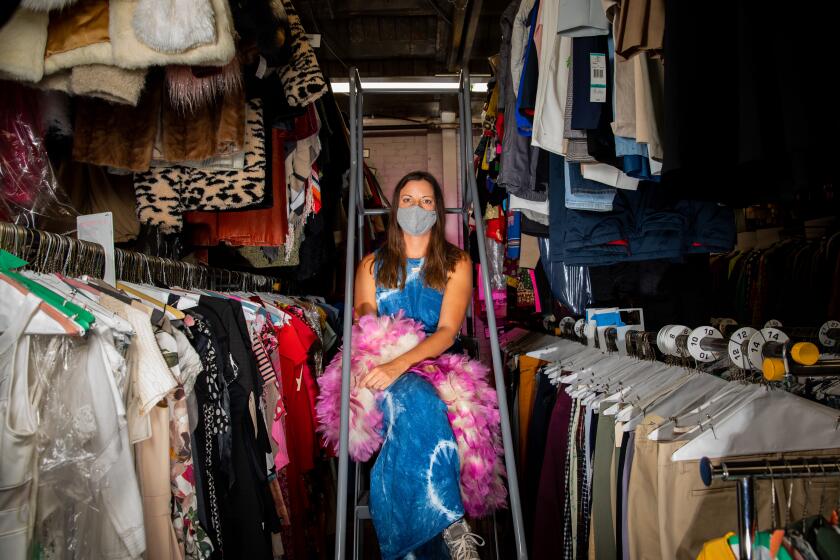L.A. location filming gets October boost but pandemic fears slow Hollywood return
- Share via
The Warner Bros. movie “King Richard” and Netflix’s series “Dear White People” helped to boost production on the streets of Los Angeles last month, but the October spike was not enough to restore location filming to prepandemic levels.
FilmLA said it received 880 applications for film permits in October, up 24% from 711 permits in September, as major studios returned to filming television shows and features.
The nonprofit group, which handles film permits in Los Angeles city and county, said it is averaging about 40 new permit requests per day, although that remains 47% below prepandemic levels.
A return to scripted TV helped drive the upswing, with permits linked to TV dramas such as Showtime’s “Shameless” accounting for 10% of requests. That overtook permits for reality shows, such as Bravo’s “Shahs of Sunset,” which generated 6% of requests.
Warner Bros.’ “King Richard,” a movie based on Richard Williams’ autobiography about raising his tennis champion daughters, Serena and Venus, is one of the few large feature films that have resumed filming in the region.
Additionally, Director Paul Thomas Anderson is filming “Soggy Bottom,” a feature set in the 1970s San Fernando Valley starring Bradley Cooper. Channing Tatum has been filming scenes in Santa Clarita for the Metro-Goldwyn-Mayer movie “Dog,” the story of an Army Ranger who takes his canine companion on a road trip up the Pacific Coast Highway.
In the wake of the pandemic, the entertainment industry created a new position on set to help keep outbreaks at bay.
Despite the upswing in activity, Hollywood has struggled to return to prepandemic production levels, hobbled by the ongoing health crisis and the ability to gather large numbers of crew safely. Most filming in the region has been confined to smaller-crewed commercials shoots.
Film and television producers also are facing higher production costs as shoots take longer and need detailed on-set safety measures, testing and compensation for COVID-19 related absences among cast and crews. So far the industry in L.A. has been able to return to work to a degree without triggering major outbreaks.
“The film industry as a whole seems to be being very responsible in their return to work, even though it means more time and more money for them to produce their content,” said Paul Audley, president of FilmLA. He noted that there have been only a few incidents of positive coronavirus cases on film sets and they had been quickly contained.
“We’re getting to a plateau that we expected, given all of the conditions of having to work under with this pandemic still being active and growing in our region,” Audley said.
In the 20 weeks since June 15, when FilmLA started issuing permits after the shutdown, it has received about 2,565 film permit applications for 1,967 projects, the group said.
Film industry officials expected the upswing after a September agreement between unions and an alliance of major producers on COVID-19 safety protocols that allowed bigger productions to restart.
Some entertainment industry unions also are showing positive signs in terms of employment. Hollywood’s Teamsters Local 399 has in recent weeks approached full employment, said Steve Dayan, secretary-treasurer of the local, which represents about 5,000 casting directors, location managers and drivers.
“We’re busy,” Dayan said. “Things seem to be going well on set and I believe that people are respecting the protocols and that’s the reason.”
The Otis report underscored the devastating impact the health crisis has had on key drivers of Southern California’s entertainment economy.
But Dayan cautioned that the upcoming holidays could bring a slowdown in work if the virus spreads. “We have holidays approaching that’s a reason to be concerned,” he said. “We have to keep our guard up.”
L.A.-based soap opera “The Bold and the Beautiful” resumed filming this summer but faced issues with testing, causing a brief delay while it changed labs.
More than 30 projects in California’s state tax incentive program requested a delay in using the credit in response to the outbreak. Only six of those projects, a mix of films and television series, have resumed physical production across the state, according to Nancy Rae Stone, director of California’s film and TV tax credit program.
Some crew have been concerned with the lack of testing on smaller commercial sets, which are exempt from the rigorous requirements of larger productions. Hollywood’s unions and the Association of Independent Commercial Producers have been in talks about COVID-19 safety requirements.
FilmLA said the average weekly rate of growth of permit requests slowed in October to 4.8%, versus 10% in September.
In recent months, streamers like Hulu and Netflix have canceled a raft of shows as a result of the challenges posed by the pandemic. One recent casualty was Netflix’s wrestling drama “GLOW,” which filmed throughout the city but was canceled last month.
In October, advertising-related shoots, for brands such as Instagram and Uber, generated the bulk of activity in L.A., accounting for 44% of permit requests, FilmLA said. Television production was the next largest share, with 25%. Feature production currently comprises around 4% of permit activity.
During the third quarter, total on-location shoot days for the film and TV industry dropped 55% year-over-year as a result of the COVID-19 crisis, FilmLA said last month. California health officials ordered a production shutdown from March 20 to June 15, causing thousands of job losses.
Commercials have driven Hollywood’s production restart in wake of pandemic, but some crews and unions say safety enforcement still falls short
More to Read
Inside the business of entertainment
The Wide Shot brings you news, analysis and insights on everything from streaming wars to production — and what it all means for the future.
You may occasionally receive promotional content from the Los Angeles Times.












